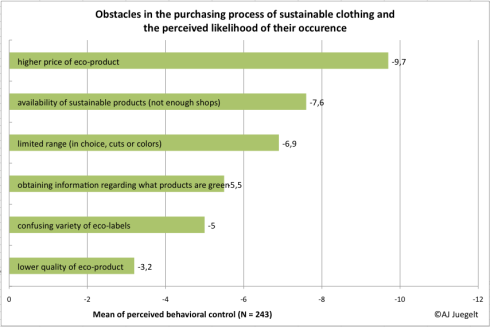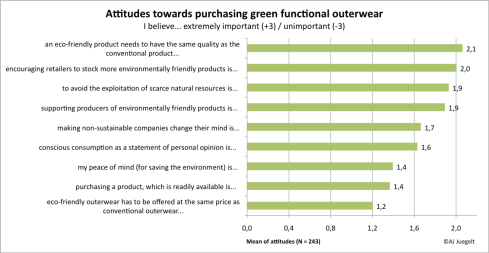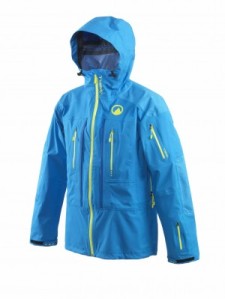You are currently browsing the tag archive for the ‘outerwear’ tag.
SECTION 3 – CONTROL BELIEFS AND THE PERCEIVED LIKELIHOOD OF OCCURRENCE
Perceived behavioral control (PBC) about purchasing eco-friendly clothing stands for the problem of implementation, the missing ability to perform environmentally or socially friendly acts. The level of PBC depends on the positive perception of facilitating factors or the negative perception of obstacles and their likelihood of occurrence, no matter if the control beliefs are rational/true or not (Ajzen 1988)[1]. Perceived control over the behavior accounts for behavioral decisions that are not under complete volitional control. This means that in the context of sustainable, functional outerwear or any other type of consumer behavior regarding eco-friendly products there are several external factors, which prohibit green consumer behavior. Six key factors were used in my paper to account for the obstacles in this context. The set of questions covers some, not all, of the key marketing issues in the areas of product development, pricing, distribution and communication. They contribute to the intention-behavior gap. This gap exists because consumers with very pronounced environmental attitudes might display a strong intention to purchase eco-friendly products (see Section 1), but get obstructed by several obstacles when trying to put their intention into action.
Therefore, the following two sets of questions were asked (as in the previous blog about the effects of social influences on the development of positive or negative purchasing intentions, the results were multiplied):
Which of the following problems affect the amount of environmentally friendly outerwear that you purchase?
- higher price of eco-products
- availability (not enough shops)
- limited range (choice, cuts or colors)
- lower quality of eco-product
- confusing variety of eco-labels
- obtaining information regarding what products are environmentally friendly
‘always a problem’ (-3) to ‘never a problem’ (+3) // note: items are reverse coded
The second step was the consumer’s perceived control or ability to act:
Please indicate below whether or not you believe that these problems are likely to occur when shopping for environmentally friendly outerwear…
Very unlikely (+1) to very likely (+7)

Obstacles in the purchasing process of sustainable clothing and the perceived likelihood of their occurrence (average per item across the entire sample)

SECTION 1: ENVIRONMENTAL ATTITUDES
Let’s start with one of the most significant influences on behavioral intention in the context of sustainable consumerism: the consumer’s attitude towards the behavior. Ajzen and Fishbein (1980)[1] define attitudes towards a behavior as a “person’s judgment that performing the behavior is good or bad, that he is in favor of or against performing the behavior” (p. 6). According to their theory “attitudes are a function of beliefs” (p. 7). In a sustainable consumer behavior context, a high degree of environmental attitudes would govern an individual’s evaluation of their purchasing behavior and thus his or her behavioral intentions.
Descriptive results: Attitudes towards purchasing environmentally friendly outerwear
So-called “behavioral beliefs” had to be rated by the participants from -3 to +3. Positive numbers stand for a positive attitudinal beliefs towards performing the behavior, vice versa. The following nine beliefs have been chosen to account for the array of beliefs that is likely to have an effect on green consumer behavior in this context:
I believe…
- avoiding the exploitation of scarce natural resources is…
- conscious consumption as a statement of personal opinion is…
- making non-sustainable companies change their mind is…
- encouraging retailers to stock more environmentally friendly products is…
- my peace of mind (for saving the environment) is…
- supporting producers of environmentally friendly products is…
- an eco-friendly product needs to have the same quality as the conventional product…
- eco-friendly outerwear has to be offered at the same price as conventional outerwear…
- purchasing a product, which is readily available is…
‘extremely unimportant’ (-3) to ‘extremely important’ (+3)
Established, big companies in the outdoor sport business want to make a move towards a sustainable future. But there are several obstacles that slow this movement down. Sourcing of quality, eco-friendly material, research & development, necessary to come up with new innovative products from recycled or renewable resources, and developing new distribution channels and context-specific messaging are only a few factors that need to be understood. By now, it has become clear to many marketing managers, that “going green” does not necessarily create higher costs on the production side, but that it’s actually possible to produce high-performance, eco-friendly products at approximately the same costs
as conventional ones. Quality is also no issue! Snowboards’ or Skis’ edges from recycled steel, impregnated wooden side walls or topsheets laminated with environmentally friendly glue and natural colors, 20.000mm recycled polyester garments in bright colors, recyclable zippers, etc. – all these product components are available in high quality at only slightly higher prices. Zimtstern’s Dominik Fuß interviewed by ISPO in 2009: “We are already able to develop reasonably priced, eco-friendly products that don’t need to cost more!
But the outdoor sports companies are still hesitant to change their entire product line to become 100% sustainable. Besides – it’s no piece of cake. While smaller and more flexible “green” start-ups can focus on profitable niche-markets, changing the production process and marketing strategy, to offer such a portfolio within only few seasons, is next to impossible for the big global players. “I think, it’s a state of mind, which needs to change in the whole company – once it’s top of mind in everybody’s head, many people come up with ideas and solutions. But this change does not happen over night.” – Maritxu Darrigrand, Head of Sustainability at Roxy.
This philosophy needs to be established within entire companies in the coming years – but this will only work, if producers and retailers can trust consumer demand. (Most often, only top of the line products, often signature series of sponsored celebrity athletes, could demonstrate that, even at slightly higher costs, they still deliver an acceptable margin through price premiums.) Consumers like to claim their willingness to pay higher prices and often see themselves as conscious consumers, while the truth is, that price and other standard product attributes still influence the purchase decisions the most. And buying behavior is also affected by social norms and perceived obstacles. One of the main hypothesis of this project is that individuals with a strong outdoor sports background (surfing, climbing, snowboarding, etc.) have a stronger connection to nature and that this connection positively influences their decisions compared to other consumers.
This research project for the Department of Service and Technology Marketing of the Technical University of Munich, Germany, has been designed to understand those effects, identify problems and find solutions. The online-survey assesses the influences on end-consumers’ purchasing behavior for environmentally friendly products in the outdoor sports segment.
Link to the survey: http://www.unipark.de/uc/eco-friendly-outdoor-products/
Thank you in advance, for participating in the study! It will take less than 20 mins. of your time and your input will help to make a difference!
The results of this study will reach the heads of sustainability, marketing managers and product developers in a lot of big, internationally operating outdoor sports companies.
Thanks to our sponsors Völkl Snowboards and O’Neill, there are some nice eco-friendly products up for grabs!!
Don’t forget to check out the 7Sky GreenRoom and inform yourself about the BlueSign label.
A little while ago I talked to the head of a well-known snowboard brand who is very much in favor of sustainability and tries to push this topic within the company. Against quite a bit of resistance he manages to overcome some internal obstacles to launch multiple products containing organic cotton. At one of the first press conferences announcing this new move he got some very critical feedback from a, let’s call him “green” journalist that said: “Well, congratulations, you have now moved to a type of garment that uses up even more water than with the previously used classical cotton.”
Since that conversation I was interested to find out if that statement was really true and if organic cotton is not such a good idea afterall. So let’s get to the bottom of the matter. Read the rest of this entry »



